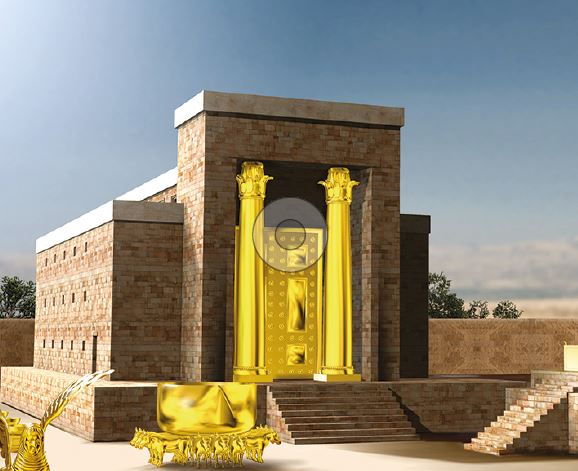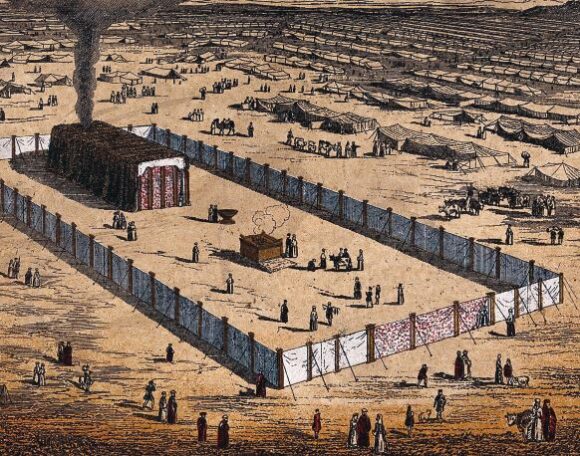WHEN GOD BROUGHT His people Israel out of slavery in Egypt to lead them to the Promised Land, they camped in the desert in a city of tents. They needed a place that was set aside specially for the worship of God, and at first they used the tent of Moses, the man whom God had appointed as the people’s leader. This tent was pitched outside the main camp (Exodus 33:7–11).
The Tabernacle
While they were in the wilderness God gave them the Law which was to govern their life and worship, which became known as the Law of Moses. And He instructed them to build a special tent to be the focus of their national worship. This tent was called the Tabernacle, and whereas Moses’ tent had been outside the camp God insisted that the Tabernacle was erected in the centre of the camp, in the midst of His people (Leviticus 15:31).
The tents of the 12 tribes of Israel were pitched in a huge square. The tents of the twelfth tribe Levi were pitched immediately around the Tabernacle, between it and the people (Numbers 1:53) —God wanted to be in the midst of His people, but they had to be aware of His holiness, and approach Him with care.
The Tabernacle was built precisely to God’s detailed instructions, and according to Exodus 40:16–17 it took a full year to finish it.
During the 38-years’ wilderness journey of the children of Israel, the whole nation moved about, and every time they set up camp the Tabernacle was erected in its centre. But when they entered the Promised Land (Canaan) it was appropriate that the Tabernacle be erected in one established place. That place was Shiloh, where it remained for over 300 years (Joshua 18:1). Shiloh was in the territory of Ephraim— the tribe of their leader, Moses’ successor Joshua—and was geographically central in Canaan.
It was at Shiloh that the Tabernacle was pitched longest. It was the site of many significant events in Israel’s history. Here the priesthood became corrupt (1 Samuel 2:12). Psalm 78:60 tells how Shiloh was eventually destroyed because of the wickedness of the people.
And it’s Psalm 132:13–14 which tells us that instead of Shiloh God chose Zion for His habitation: “This is My resting-place for ever; here I will dwell, for I have desired it.” Zion is Jerusalem.
And so King Solomon, following the pattern which God had showed his father King David, built the glorious Temple at Jerusalem (1 Kings 6).
The Temple
Although the Temple, like the Tabernacle, was in the midst of God’s people, there were degrees of separation as to how people could approach and worship there: first there was the courtyard which was open to both Jews and Gentiles, though Gentiles could go no further on pain of death. The next space was the outer sanctuary, known as the Holy Place, and here only priests and Levites could enter in the course of their duties; then there was the inner sanctuary, known as the Most Holy Place, where only the High Priest could enter, and that only with suitable precautions and preparation, once a year on the Day of Atonement.
Solomon’s Temple was destroyed in the judgements of God against the people’s wickedness, when the Babylonians burnt and sacked Jerusalem in 586 bc. A replacement was built by King Herod, and this was destroyed in 70 ad by the Romans. Jesus had told the Jews beforehand, “See, your house is left to you desolate” (Matthew 23:38). It was no longer God’s house, they had rebelled against Him and He had abandoned it. It has never been replaced. So where is the house of God in our age?
We have seen the principle that God wants to be in the midst of His people—He wants us to be near Him. In the days when the Temple still stood, God said to His people, “Thus says the Lord: ‘Heaven is My throne, and earth is My footstool. Where is the house that you will build Me? And where is the place of My rest? For all those things My hand has made, and all those things exist,’ says the Lord. ‘But on this one will I look: on him who is poor and of a contrite spirit, and who trembles at My word” (Isaiah 66:1–2).
God, as the Creator of heaven and earth, can live anywhere—no mere earthly building can contain Him. But He is willing to dwell with any man or woman who wants Him to dwell with them. That’s why the Lord Jesus said, “If anyone loves me, he will keep my word; and my Father will love him, and we will come to him and make our home with him” (John 14:23).
The Church
We have to remember that a church does not consist of the place or the building where services are held. In the New Testament a church is always the body of people who make up the congregation. The word translated “church” is the Greek word “ekklesia” (compare our English words such as “Ecclesiastical”). I understand that “ekklesia” was the word used in everyday Greek when an assembly was called for a village or community to discuss specific issues or problems or situations. The people were “called out” from their homes to meet as a community to discuss and decide on civil issues. So the New Testament speaks of God “taking out” a people to bear His name (Acts 15:14), and these people become the “church”.
And so the church is the dwelling-place of God on earth, the place where He is worshipped. (Christadelphians tend to prefer the words ‘meeting’ or ‘ecclesia’ to avoid confusion, because the word ‘church’ conjures pictures of a building in many people’s minds.) In 1 Corinthians 3:16 Paul says to his readers, “Do you not know that you are the temple of God and that the Spirit of God dwells in you?”
Experiences during the Coronavirus lockdowns in many countries have shown that believers don’t actually need to be in the same location—with the benefit of modern technology services have continued online. One benefit of the lockdown experience is that we discovered a means whereby members of the meeting can attend all kinds of services even when they’re not physically able, through frailty or for other reasons. But the experience also demonstrated how precious it is for brothers and sisters to be actually physically together.
Some suggest that the worship of God requires a special building. We’ve seen that this isn’t true. At the other extreme, some suggest that worship is an individual affair, which might be conducted in a roadside kiosk for maximum convenience. We can also see that this is not true worship. A real church is a unity of fellowship in the midst of which God dwells.
In his splendid vision of the Kingdom of God, the Apostle John looked into the future and saw God and Jesus themselves become the new temple, where like the Tabernacle of old, they will dwell in the midst of their people (Revelation 21–22). You and I can be part of that new and glorious order of things in the Kingdom when Jesus returns, if we are members of his church now.
J Hamilton Wilson



